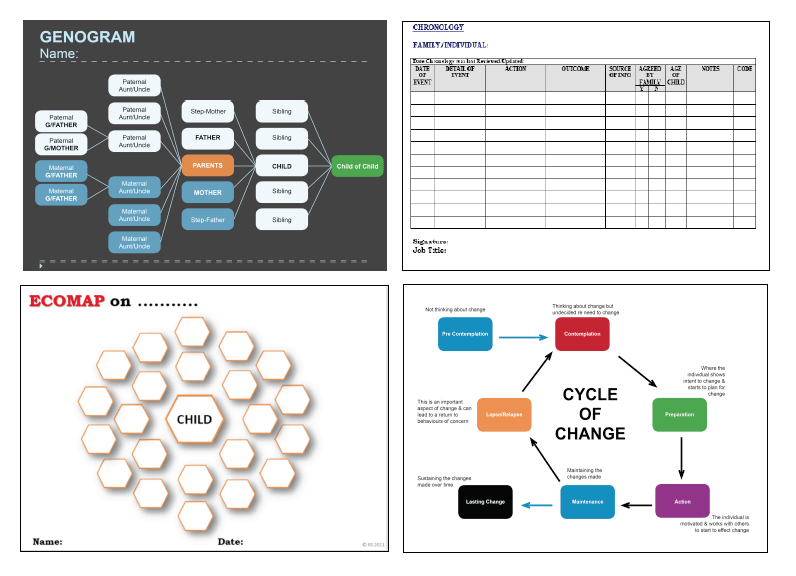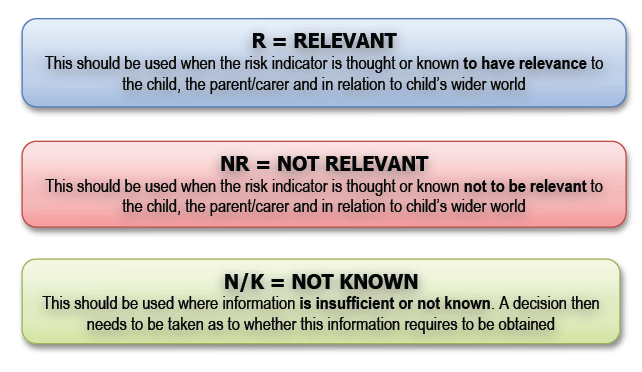National Risk Framework to Support the Assessment of Children and Young People
The document is a national risk assessment 'toolkit' for child protection to support practioners in identifying and acting on child protection risks in children and young people.
2.2 Stage 1 - Collection and Collation of Information
At this initial stage, the focus of practitioner activity is the collection and collation of information and this process can be enhanced by the use of the Risk Indicator Sheets and the appended tools such as Genograms, Chronologies, EcoMaps and Cycle of Change. (Refer to Sections 2 and 3)

Risk Indicators
To assist practitioners in the gathering of information a series of Risk Indicator Sheets have been developed that build upon the My World Triangle and provide additional information for practitioners assessing risk and the impact that risk factors may have on the safety and well-being of the child.
The Risk Indicators are drawn from current research findings and directly informed by frontline practice experience. While comprehensive they do not seek to be exhaustive. They encourage practitioners and those examining risk to consider the wide spectrum of need/s prevailing and identify particular areas that may not otherwise have been considered by them, but which through research have been highlighted as important.
- Risk Indicators - these help practitioners to look at a range of possible risk factors within a child and families life. As such they support single/multi-agency assessment and enable practitioners to explore multiple areas of potential/actual risk. This will help inform information gathering, and decision making about the need to share concern beyond the single agency.
- Where there is the need to share concern across agencies and develop multi-agency assessments and interventions, practitioners should comprehensively consider not only the Generic Risk Indicators and Risk Questions/Prompts but also the Matrix and Resistance Related Risk Indicators.
How to Use the Risk Indicators and Recording Sheets
- The Risk Indicator Recording Sheets provided, take practitioners through a series of potential risk indicators, allowing information to be gathered, examined and recorded in a methodical and systematic way. This better informs the analysis of risk and supports decision making in a way that helps establish a strong evidence base. The Recording Sheets can also be easily attached in the form of supporting information as an appendix to single or multi-agency assessments.
- The risk indicators seek to provide a clear focus for exploration and discussion by the practitioner, child and family. THEY ARE NOT INTENDED to be a set of questions that workers sit and work their way through with children/families one question at a time. Rather they provide an aid to ensuring that potential aspects of risk are actively considered and, as information is gathered, fully recorded.
- They also provide a focus for discussion and debate between professionals as concerns are explored, levels of risk are agreed and interventions decided upon (eg. within the context of the child protection core group).
- The Record Sheets have been developed to allow up to FOUR[2] children within the one family to be individually considered. This allows consideration and comparison of need/risk across sibling groups without the need to start using another Record Sheet. When completing the sheets the following key should be used:

EXAMPLE RECORD SHEET
| Risk Indicators | Child 1 | Child 2 | Child 3 | Child 4 | Notes |
|---|---|---|---|---|---|
| Premature birth/low birth weight | R | NR | NK | R | Two known premature deliveries with Child 1 and 4 (Midwifery and Maternity Hospital Records) |
| Early prolonged separation at birth | R | NR | NR | NR | Child 1 experienced early separation that was not known to have been experienced by the other 3 children |
| Baby born with substance withdrawal (NAS) | R | NR | NR | R | Child 1 and 4 both experienced NAS while Child 2 and 3 seem not to have |
Each indicator needs to be considered and comment put against each
R = Relevant NR = Not relevant N/K = Not Known
Notes or comments on each Risk Indicator can be recorded where necessary and practitioners can also record the source of any evidence pertaining to each. Having gathered information and using the series of questions and prompts, the recording sheets can then be systematically used by practitioners to better answer the question, "what it is the information telling me?", leading logically to Stage 2, Risk Analysis.
Contact
There is a problem
Thanks for your feedback